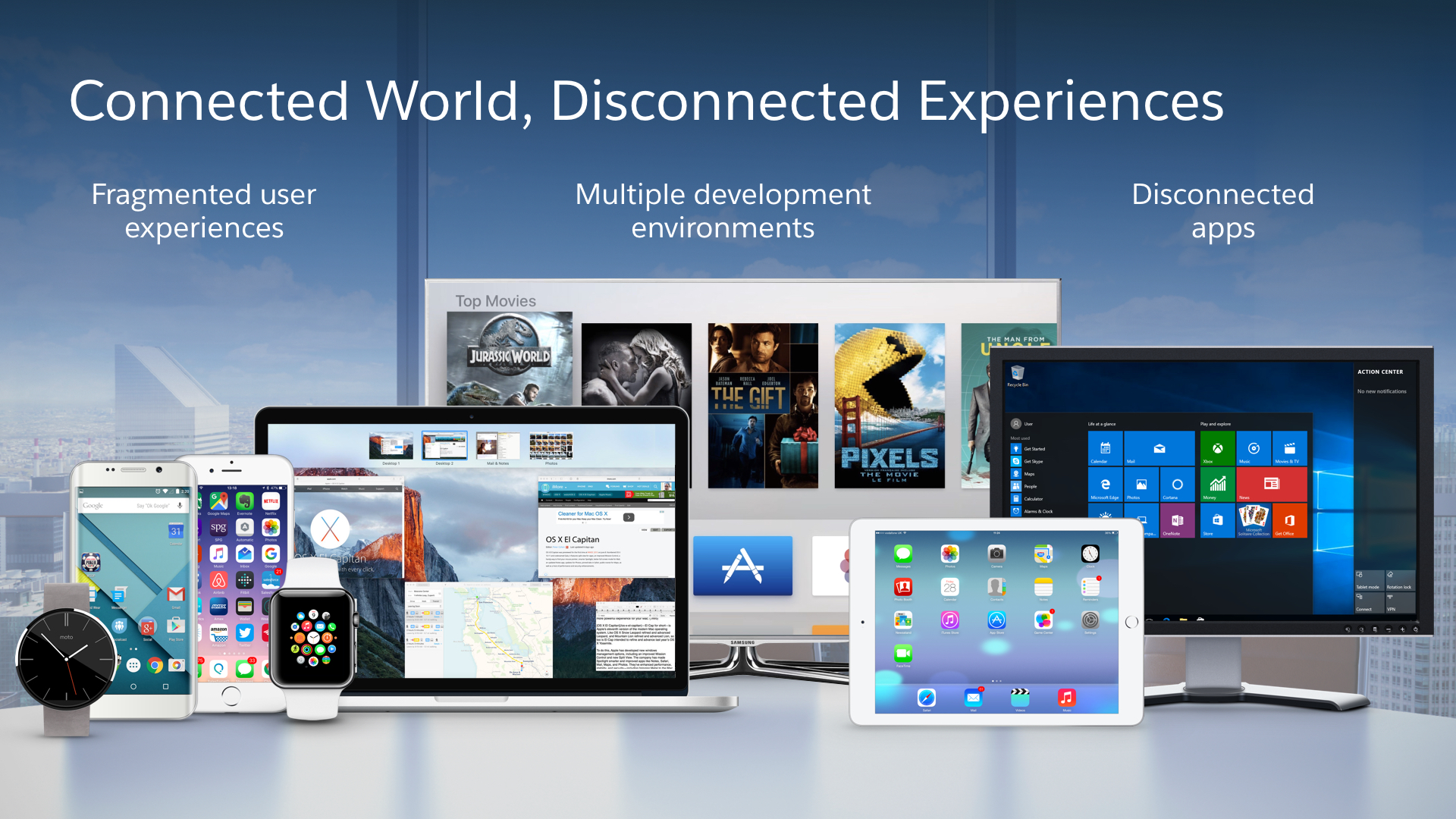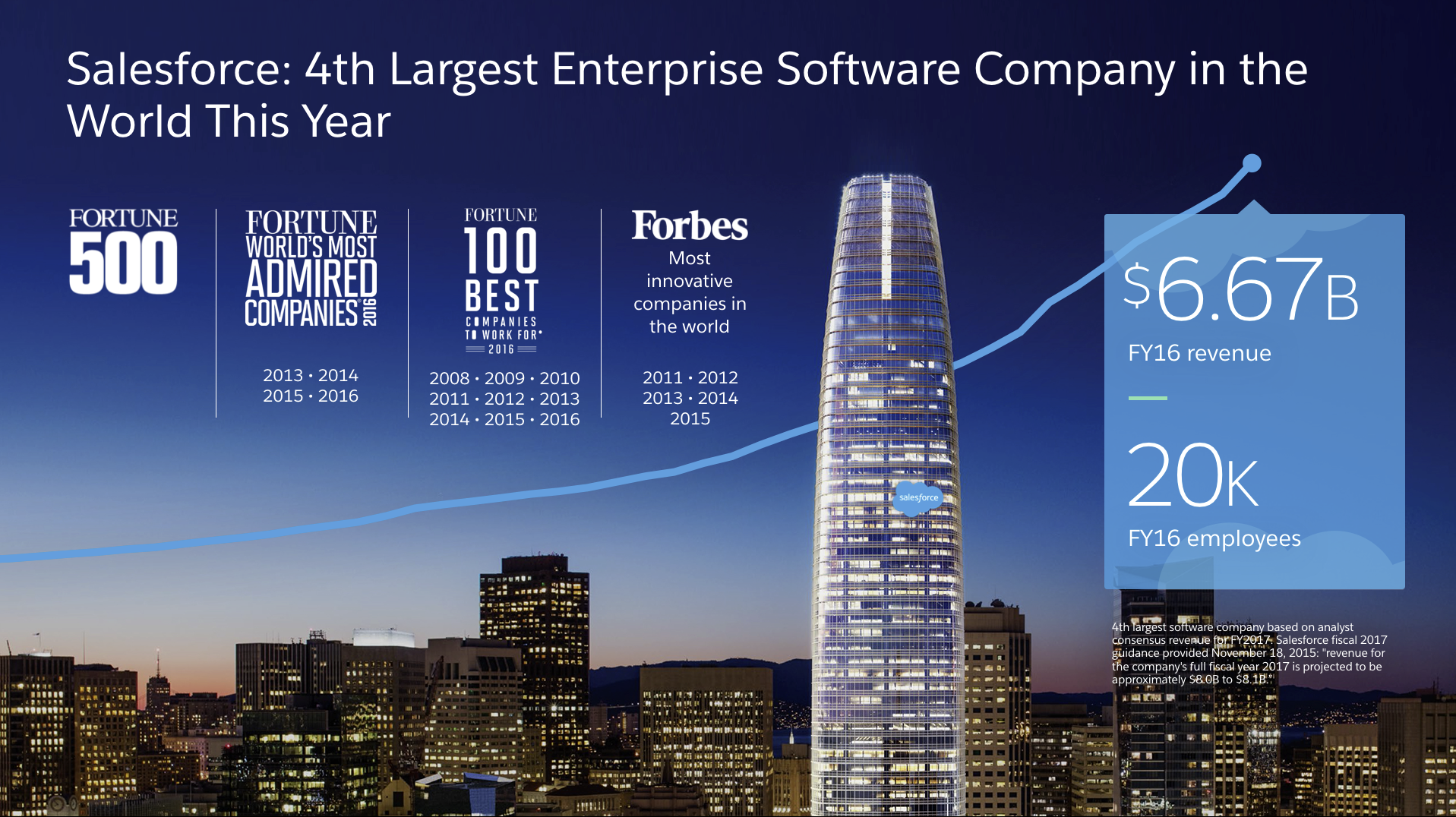
Get your FREE 30-day trial.
Please complete all fields.
Here’s a situation we can all recall: you have to give a presentation, and it’s time to start that slide deck. You start by opening up the application, making a title slide, putting some bullet points on the intro slide, and inserting a cute picture — before you hit a wall. Then you give yourself kudos for getting this far and go get some coffee. Have you ever said to yourself, “I’m just terrible at PowerPoint”?
You’re going about it all wrong.
It’s not about how pretty your slides are (well, it is, but that comes later.) The basis of designing and delivering an awesome presentation is to craft a story and use visuals to support and strengthen that story. Guy Kawasaki famously said, “95% of presentations suck.” We’re here to get you into that 5%.
Three of Salesforce’s experts weighed in on crafting effective, impactful, and beautiful presentations. Sara Cattanach creates content for the keynote presentations at Salesforce Essentials and World Tour events, and trains speakers to deliver great presentations. Aaron Rabideau and Gabrielle Tabios are the masterminds behind the presentation visuals at Salesforce’s largest events, including the Dreamforce keynote. Over and over again, they stated that slide design exists to support the presentation narrative.
If you can't watch the keynote now, download our free e-book adapted from the presentation.
Some of the best presentations — State of the Union, Ted Talks — have little or no visual elements. A slide deck is there to back you up, not to be the central focus. You want your audience members to leave saying, “what a great presentation,” not “what a great deck.” Your spoken delivery of the presentation is what will convince, inspire, or educate your audience.
Here’s the first secret: Get the narrative, and titles, down completely before you start on the visuals. Otherwise, you’ll be rearranging slides and editing content when you change your story; you’ll end up doing twice the work on the presentation design elements.
When Cattanach is at square one, starting a new presentation, she begins in a spreadsheet by writing out the narrative, each slide title on its own row. When she has the story down, she goes to the speaker for the first round of feedback — before making a single slide.
Secret #2: Write the story of your presentation the way you write an essay. There should be a beginning, middle, and end. Different industries will have different ways of crafting stories, and knowing your audience is essential. Here are a few common structures:
Thesis, supporting points, conclusion
Summary, question posed, hypothesis, exploration, conclusion
Problem, solution (it’s your company), how your offerings work, call to action (e.g. Learn more here, or Go deeper with small-group event sessions)
For a key or novel idea: What exists now, compare and contrast feature by feature
Every presentation should be tailored to your audience with a clear goal in mind. Is the point to convince investors to back your product? That’s a very different presentation than the first call deck your sales team will use about that same product. A presentation to your peers about research findings may rely much more on text and supporting stats than that same content delivered to an audience who is not as immersed in the field.

"Problem" slide

"Salesforce is the Solution" slide
Rabideau breaks slide design into three basic tenets:
1. What’s the story? (What is the narrative, and what should the audience take away?)
2. How does it look? (The nuts and bolts)
3. How does it work? (The usability of the template)
The first step he takes when sitting down with a speaker is to say, “Tell me what it is you want me to know.” Rabideau’s tips center around two basic goals for visuals: have each slide reinforce (not distract from) the points in the narrative, and make the presenter appear to be a knowledgeable and skilled expert.
People are inherently problem solvers. If they see something wrong on a slide, they may not have the design eye to pick out exactly what’s wrong, but their attention will be wrenched from what you are saying to figuring out what’s off. By the same principle, putting up a funny but slightly blurry comic will redirect your audience’s attention to making out the fuzzy joke. Visuals are there to support the speaker, and should never detract from the spoken presentation (read: no slides full of long bullet points or low quality Google-sourced images!)
Taking the extra time up front to clean up your slides reinforces that you are taking your presentation, audience, and message seriously. It’s why companies will spend big money on creative agencies who obsess over the details of an ad — if something is sloppy, it reflects poorly on the company. Set yourself up for success by creating consistency and a high standard for quality throughout your deck.
By now, you should be convinced that PowerPoint is not your starting point. After you have nailed down your story, and the titles of each of your slides, you can finally get to what you came to this article for: creating impactful slides. The minute details and wizardry of slide creation are best left to training courses, but there are some important points to take home.

1. Each slide should convey one idea — if there are two ideas, break it into two slides. Tabios lays out a basic slide breakdown: the top level thing is what you want the audience member to grab right away (a callout, a key visual, or the title). The secondary element supports that first thing, and smaller elements can also be inserted, if they don’t overwhelm the slide.
2. Consistency is key. Slide elements should be aligned: things sit in the same place, are the same color, are the same size, and have the same amount of space between them. Use bold minimally and a maximum of one highlight color.
3. Minimize text. The details of a slide — a picture, callout stat, quote, or subtitle — can support what you’re saying, but the slide shouldn’t speak for you. Newer speakers may need longer titles to help them remember the narrative while presenting. The better you get at storytelling the less you will need those cues, and the more you can pare down the text on your slides to put your audience’s focus on your words.
4. Put a lot of thought into how your images support a slide’s key idea, make sure you use high-quality images, and consider using recurring images. Salesforce uses customer heroes that are tailored to our audience — customers who champion a specific product or are from the segment or industry that best matches who’s in the room. We often introduce this hero at the beginning with a theme — like “customer success” — and then bring him/her back in at later points to remind the audience of that theme. Even if they don’t consciously pick up on the reminder, using a recurring high-impact image will help shape your story arc and give consistency to your message.
Rabideau gave one final piece of advice for designing slides, a pithy manifesto: